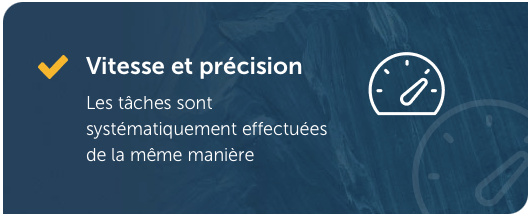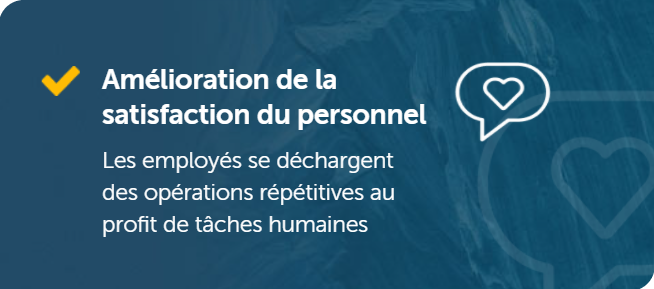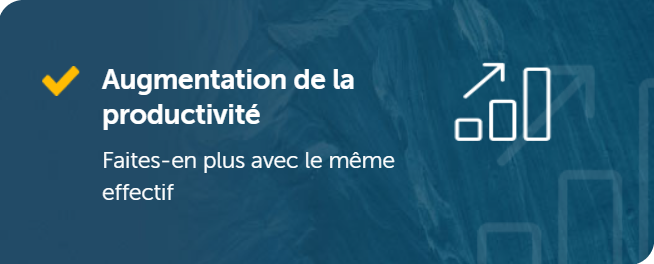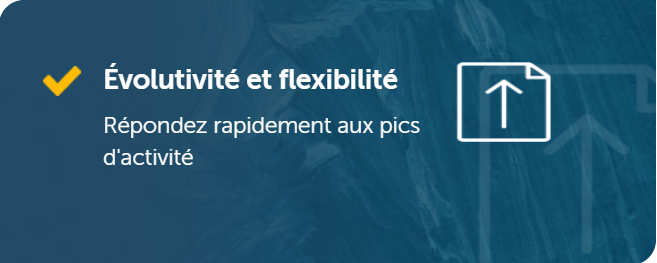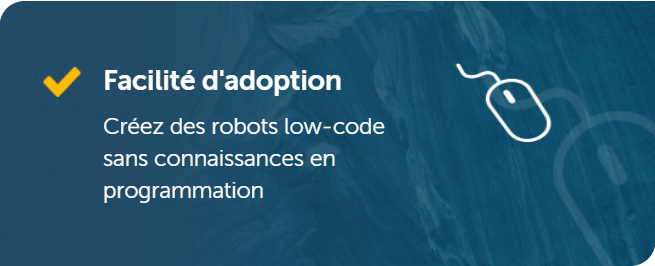RPA Process automation through robotics
Software designed to automate any business process
What is RPP?
Robotic process automation, or RPA, is an easy-to-use software technology that automates digital tasks.
With RPA, it is possible to create software robots that can learn, reproduce and execute rule-based business processes. RPA users can design robots by analysing the digital operations performed by humans. Show them the tasks to be performed, then let them do the work. Software robots interact with systems and applications of all types in the same way as people, with a few differences: they are operational 24 hours a day, work faster and ensure complete accuracy.
What are the benefits of RPP?
Why choose the RPA
- Benefits of RPA
- Increased productivity
- Maximum accuracy
- Cost reduction and fast ROI
- Cross-platform integration
- Customer experiences
- Exploitation of AI
- Scalability
The advantages are numerous...
Robotic process automation has a positive impact on business operations and results. RPA provides immediate measurable benefits in terms of cost reduction, increased accuracy and responsiveness, and continues to add value as it expands throughout the organisation. The technology improves business metrics such as customer satisfaction and generates competitive advantages by refocusing staff on what they do best: problem solving, process optimisation, analysis and other value-added tasks. This leads to increased employee engagement and new revenue opportunities.
By operating autonomously, RPA robots speed up workflows and task execution, thereby increasing staff productivity. In information-intensive industries such as financial services, insurance and public administration, for example, these robots can take over form filling and claims processing.
Total accuracy eliminates the need for grinding and ensures near perfect compliance. With RPA, industries such as finance, healthcare and life sciences are taking advantage of the reliability of robots to conduct their business in strict compliance. In accounting, order-to-cash and procure-to-pay processes are becoming more efficient and accurate.
An intuitive and accessible interface allows anyone to quickly master robot creation and generate a return on investment. For the average employee, this is equivalent to eliminating 40% of their daily workload, which is often manual administrative tasks. In industries such as healthcare, the value of automation is increased tenfold by the critical importance of accuracy and compliance in patient care.
RPA works independently of applications so that no upgrades or replacements of existing systems are required. Robots make it possible to eliminate technology silos by connecting software tools of all types, used in both the front and back office. The result? Achieve an unprecedented level of collaboration and efficiency to realise the full potential of your human capital investment.
On the customer side, assisted RPA robots facilitate customer interactions by doing all the systems work and data entry. This results in shorter processing times and a 50% improvement in customer satisfaction. Sectors such as telecommunications and life sciences are deploying robots to optimise the management of customer requests and call peaks.
The combination of AI and RPA is expanding the scope of intelligent automation by processing unstructured data, which accounts for 80% of business data. New automations are thus emerging. Examples include processing atypical invoices in procure-to-pay operations, extracting claims data and detecting fraud in the insurance sector, and receiving requests according to employee intent in the HR field.
RPA enables you to streamline high-volume business processes, but also to adapt them in times of uncertainty or in changing environments. You can manage all peaks of activity, whether planned or unplanned, by expanding your digital workforce as soon as you need it, all through a consumer interface that is simple and intuitive.
Ensure your success with RPA
- Discovery
- Preparation
- Commitment
- Demonstration of feasibility
- Pilot test
- Centre of excellence
- Expansion
- Digital transformation
Discovery
What is your vision of digital transformation?
Assessing your readiness for RPA (the next step in the RPA transition) is closely linked to your company's approach to digital transformation.
If you are just starting the process, ask a lot of questions internally and also to external stakeholders. Contact partners, suppliers and other trusted organisations that have already started their transition to RPA to gain insight into the ins and outs of the process.
Tip: Keep people at the centre of your projects. Talk to a wide range of stakeholders and consult human resources managers early on. In the long run, employees at all levels of the company will become the change agents and promoters of RPA.
Who will be the RPA leaders in your company? And what will be your first automation project?
What is your vision for digital transformation? There are two key roles to fill: your RPA sponsor and your RPA ambassador. The RPA sponsor is the automation expert in your company and is the person who has influence over the budgeting process. and the RPA ambassador is the person in charge of the project. The RPA ambassador will work with the people in charge of the different departments in your company to identify the processes that are suitable for automation. Conduct a proof of concept and/or launch a pilot project by targeting high value-added automatable processes and defining success criteria in advance.Engagement with RPP providers
Select the solution and support model best suited to your needs.
The golden rule? Think long-term. RPA and intelligent automation is a constantly evolving market. A trusted supplier will be able to demonstrate experience and business stability, and will be able to adapt and innovate.
In a perspective of expansion and digital transition, RPA can only be successful if the user is able to automate the processes by himself. Therefore, you need to choose software that is technically powerful, but also extremely intuitive.
Demonstration of feasibility
Test your business case, implementation model and assumptions against your company's situation.
The purpose of your proof of concept is to test the validity of the assumptions you have made and to evaluate your deployment plan.
Remember: it is important to choose a process that can generate considerable gains from automation, not one that is low risk. The exercise will be all the more fruitful if the process selected involves a large number of applications and IT systems.
RPA driver
Test RPA in real-life conditions.
The next phase is to deploy an automated process in the daily operations of your company.
Remember: it is important to choose a process that can generate considerable gains from automation, not one that is low risk. The exercise will be all the more fruitful if the process selected involves a large number of applications and IT systems.Your RPA pilot programme should follow the implementation plan defined in the proof of concept. This is to compare the performance of the pilot against the success criteria and targets set beforehand. Make sure that you involve all the people involved in the project. Gather and use their feedback to prepare for the roll-out of RPA to the rest of the organisation and to facilitate its adoption.
RPA Centre of Excellence (CoE)
Centralise your RPA monitoring activities and standards. Anticipate large-scale deployment of RPA by creating a Centre of Excellence (CoE) focused on efficiency and monitoring, which defines standards and provides best practices, templates and tools for professionals who create robots. The Centre of Excellence brings together all the knowledge in RPA to help the different departments and teams in the company to develop and optimise their own automation. Its mission is to define standards and provide best practices, templates and tools for professionals who create robots. The centre of excellence brings together all the knowledge in RPA to help the different departments and teams of the company to develop and optimise their own automations.Expansion
Create a sustainable dynamic by democratising the use of RPA.
It is at this stage of the digital transition that the ease of use of software becomes important. The expansion of RPA as an end-to-end solution depends on the ability of staff to use it on their own.
With the guidance of your Centre of Excellence, all your teams can design robot creation functions that will become the drivers of automation. The CoE will focus on monitoring progress, publishing best practices, highlighting success stories and continuously improving resources and knowledge.
Digital transformation
Discover the results generated by a total involvement of the company in RPA.
RPA is a driver of digital transformation. Not only does it offer an affordable way to digitise business processes, but it also transforms the daily lives of employees. It thus paves the way for even more complex and intelligent optimisation and for a transformation of the working world.
When it is an integral part of the business, automation breaks down digital silos and simplifies increasingly complex processes. People can then use their creativity and inventiveness to solve new problems.
In which sectors is RPA used?
The advantages are numerous...
Reduce costs and improve the customer experience by automating the prioritisation and allocation of receivables.
Open a new era of financial services by automating the processing of new applications
How to deploy RPA
Discovery Bot

Bot Insight

IQ Bot

AARI

RPA workspace

A platform combining RPA and AI to automate all business processes
Bot Store

Frequently asked questions about the RPP
With the speed of change, it is sometimes difficult to get clear answers to fundamental questions. We believe that RPA is a tool that belongs to everyone. So we're here to help. Here are clear answers to the most common questions about this automation technology that no one should be afraid to ask!
What does RPA mean?
What are RPA robots?
Is RPA the same as intelligent automation?
What is intelligent document processing?
Is the RPP free?
Why use RPA?
- Automate any business process from start to finish
- Connecting front and back office processes
- Organising and processing complex data
- Delete errors and exceptions
- Strengthening the security of operations
- Ensuring compliance
- Improving the customer experience
- Freeing up employees
- Enjoy an excellent return on investment
